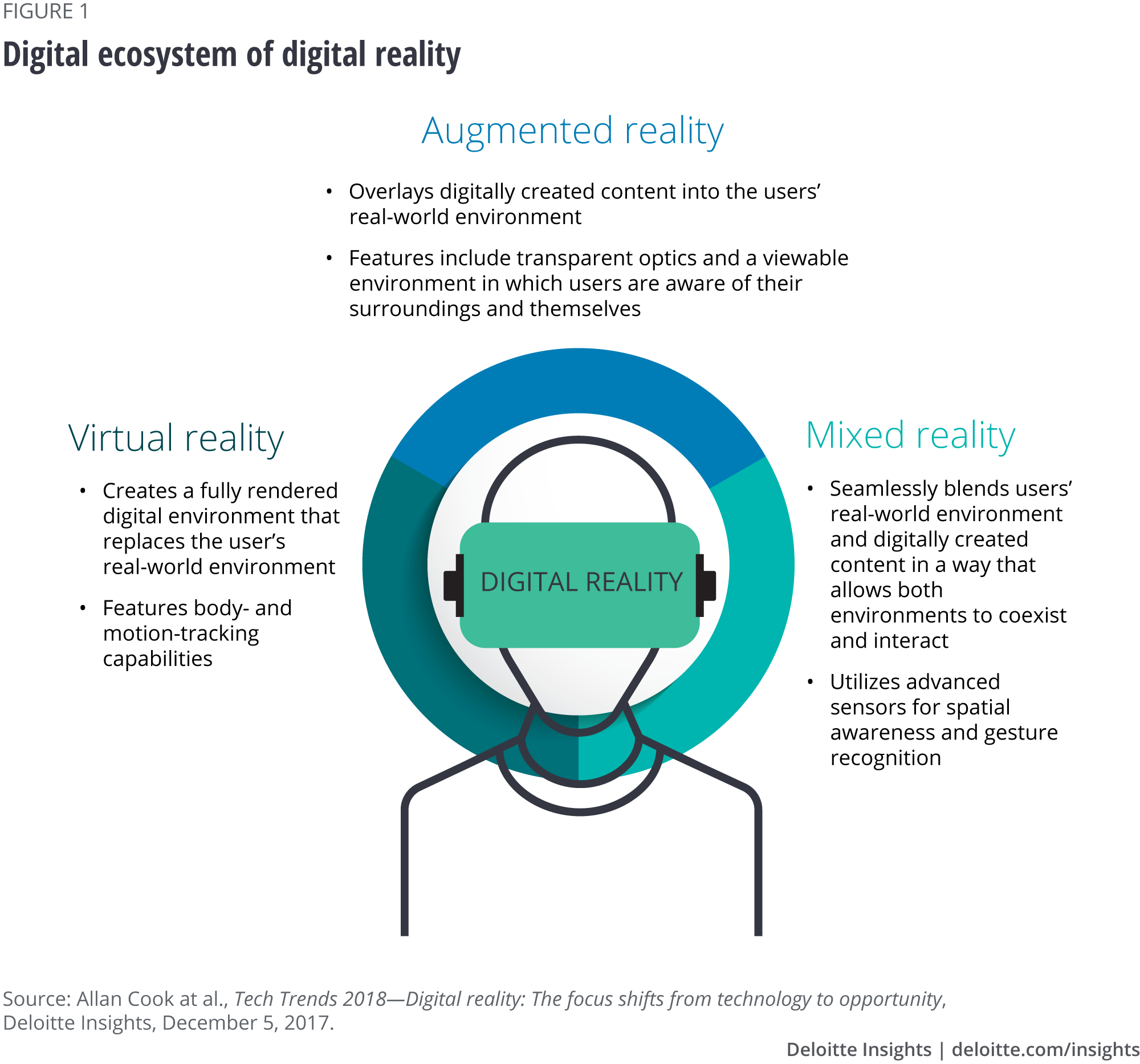
The adoption of disruptive technologies in the consumer products industry Spotlight on digital reality
4 minute read
20 February 2019
Digital reality applications in the consumer products industry have the potential to create operational efficiencies for companies as well as unique products and buying experiences for consumers.
Learn More
View the Disruptive technologies in consumer products series
View the infographic on the Disruptive consumer product technologies
Explore the Retail & consumer products collection
Subscribe to receive related content
Digital reality is one of the many disruptive technologies that can help build a competitive advantage for consumer products companies. Digital reality comprises newer, innovative technologies (figure 1): augmented reality (AR), virtual reality (VR), mixed reality (MR), 360-degree video, and immersive/spatial technologies.1 AR, VR, and MR are currently the most widely used applications, while 360-degree video and immersive technologies are in their nascent stages.2 Digital reality technologies can result in increased operational efficiencies for companies while offering advanced methods for consumers to interact and experience products prior to buying them. Often, digital reality product experiences help consumers make more informed purchase decisions.

The potential use cases we’ve observed for digital reality in the consumer products industry (figure 2) result in several benefits to both companies and consumers. Companies can benefit by:
- Creating effective marketing and advertising through enhanced brand engagement experience and contextualization of information for their consumers
- Driving innovation by capturing and analyzing real-time product performance data
- Improving employee effectiveness while saving costs and time through real-time and interactive training
- Increasing efficiency in maintenance and servicing of equipment by virtually engaging the services of an expert
- 3D and interactive visualization of products, furniture, and vehicles in the consumer’s space to help increase sales and to reduce returns

For consumers, the potential benefits of digital reality applications can include:
- The opportunity to virtually engage with products prior to making a purchase decision, potentially resulting in an enhanced and more satisfying shopping experience as well as dramatically lowering returns
- Personalized product suggestions that better suit consumers’ individual requirements
- Product transparency. As consumers continue to demand more information about the products they use, AR makes it easier for companies to share product instructions, demonstrations, and detail on ingredients or contents.
CASE STUDIES
Mattel uses AR to allow consumers to preview its Hot Wheels playsets
Mattel deploys AR to both attract and allow shoppers to experience its Hot Wheels line to make an informed purchase decision without needing to spend money. Hot Wheels consists of 12 different Hot Wheel City sets ranging in cost from US$10 to US$70. When in stores, consumers can point their smartphones at the toy box to generate a virtual setup of Hot Wheels, allowing them to visualize and experience how the car would traverse through the track.3
Tyson Foods relies on VR-based safety training to reduce worker injuries
The food processing industry requires employees to maintain the highest standards of safety and efficiency. To ensure this, employees at food processing units need to undergo rigorous training programs. In 2017, Tyson Foods deployed VR to drive general safety and hazard awareness trainings for its employees with a goal of reducing injuries by 15 percent. Following this training, Tyson experienced a 20 percent reduction in injuries and illnesses of its employees compared to the prior year.4
Digital reality applications can help build a company’s brand reputation for being innovative
Digital reality-based applications are rapidly moving from concept to reality while offering benefits to consumer products companies and their consumers. Companies can improve employee effectiveness, realize increased operational efficiencies, drive innovation, and better communicate with consumers. Consumers can enjoy an enhanced customer experience in all stages of their purchase journey.
To build a reputation for being innovative, consumer products companies will likely benefit from reviewing and adapting the use cases we’ve identified as well as by developing ones tailored to their organizational needs. As observed in our discussion on artificial intelligence, as consumers become increasingly comfortable with their digital reality experiences, they will likely come to expect and rely on companies to deploy digital reality applications to inform their purchase decisions and provide a more satisfying shopping experience.
© 2021. See Terms of Use for more information.
More insights for retail & consumer products
-
Capturing value from the smart packaging revolution Article6 years ago
-
M&A for growth in consumer products sector Article6 years ago
-
Adapting to food labeling laws through blockchain and IoT Article6 years ago
-
Looking beyond millennials for brand growth Article6 years ago









